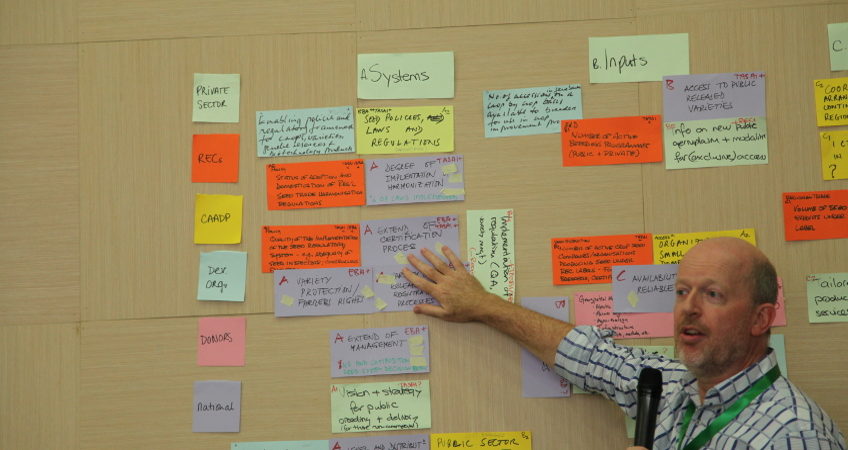An Expert Consultation Workshop was held in Abidjan last October which shed some light on the measurement of seed sector performance in Africa. Attended by more than 40 participants, this meeting has been key to promote renewed awareness and commitment on the need for a more efficient and sustainable seed sector in Africa. The Workshop was jointly organised by AfricaSeeds, the pan-African institution in charge of implementing the African Union seed program, and ISSD Africa, a three-year old program supporting integrated development of the seed sector in Africa. The Workshop has been made possible thanks to the financial support of the Bill and Melinda Gates Foundation, the GiZ and the Government of The Netherlands.
Putting numbers on seeds
To better assess and manage seed production and use in the continent, stakeholders must be able to map what is available in the seed sector. Figures about the various aspects of the seed sector can improve accountability and transparency of operations at all levels. At the continental level, they can contribute to Comprehensive Africa Agricultural Development Programme (CAADP) implementation through the CAADP Results Framework. At national level, they provide a solid reference against which efforts can be planned, monitored and evaluated. At farm level, they can be used to improve efficiency of seed production and enhance market links.
Yet mapping the seed sector in Africa can be challenging. The wide variety of actors involved – from smallholders to high-level decision makers – and their different information needs make the task complex. Most farmers in Africa are smallholders who self-source their seeds. Information about quantities, varieties and quality of the seeds they use is therefore difficult to capture. In addition, the nature of the seed production areas, predominantly remote and very diverse, makes data gathering particularly costly. What is more, the term seed encompasses the variety of forms. Those range from tiny vegetable seeds to vegetatively propagated materials, with the corresponding variability in terms of planting, processing, storing and marketing practices. This adds to the intricacy of the data management process. Generally low levels of investments in the sector, coupled with a lack of recognition of the role of quality seeds in the fulfilment of agricultural transformation, are further constraints to measuring seed-related issues.
Demand for information
The demand for information on seed sector performance is nonetheless overwhelming. It is clear that without the ability to measure how a specific seed system is performing, chances are poor that appropriate and timely actions can be taken to improve it. In the absence of mechanisms to measure progress, lack of transparency and accountability of the sector becomes a rule rather than an exception. For accurately planning initiatives, it is necessary to be able to locate, quantify and qualify the demand of seeds. Potential investors, including entrepreneurs, need information to decide when, how and where to invest.
The Expert Consultation Workshop served the important goal of pulling a variety of information users together and allowing them to set out and clarify their respective needs.
The participants were representatives of governments, regional economic communities, the private sector and development and donor organisations. To best capture the information needs of stakeholders, the participants broke out into working groups. A conceptual framework was used to articulate the information needs based on the various sub-domains of the seed sector. This has proved useful to highlight the priorities of the various stakeholder groups and identify specific information requirements.
Current initiatives
The Workshop was also an opportunity to promote the understanding of ongoing initiatives measuring key aspects of seed sector performance. Five main initiatives exist that were presented: the Word Bank’s Enabling Business in Agriculture, the African Seeds Access Index of the Cornell University, the Access to Seeds Index, the Agrobiodiversity Index and the National Seed Dashboard of the Bill & Melinda Gates Foundation.
Group work and plenary sessions allowed to extract variations, duplications, synergies and gaps of these initiatives by stakeholder group. The topics discussed included the development of indicators for tracking informal seed sector performance, the need to map biodiversity, the possible collaboration between the presented initiatives and beyond, as well as the importance to connect the indices to the biannual review processes of the CAADP Results Framework both at the continental and the national levels.
Ways forward
The need for a synergy about common indicators between the various initiatives seemed to be an emerging consensus that can inform both the CAADP framework and national level interventions.
Overall, this Workshop is a clear example of the impact that AfricaSeeds can have in implementing its mandate: when key partners are brought together, to share knowledge and experience and identify common opportunities and priorities, the coordination of seed related issues improves hugely. Collaborations of this kind are what the African Seed and Biotechnology Program (ASBP) calls for.
At the end of the Workshop, AfricaSeeds committed to take the lead in forming linkages between the various initiatives and processes on seed indicator development. AfricaSeeds next steps will be geared towards facilitating interactions between partners, and developing a reliable Knowledge Gateway on seeds in the next few years. The Gateway, jointly owned by stakeholders, will be designed to serve the needs of all players and will bring together all the information into one source and will be made freely available to all.
